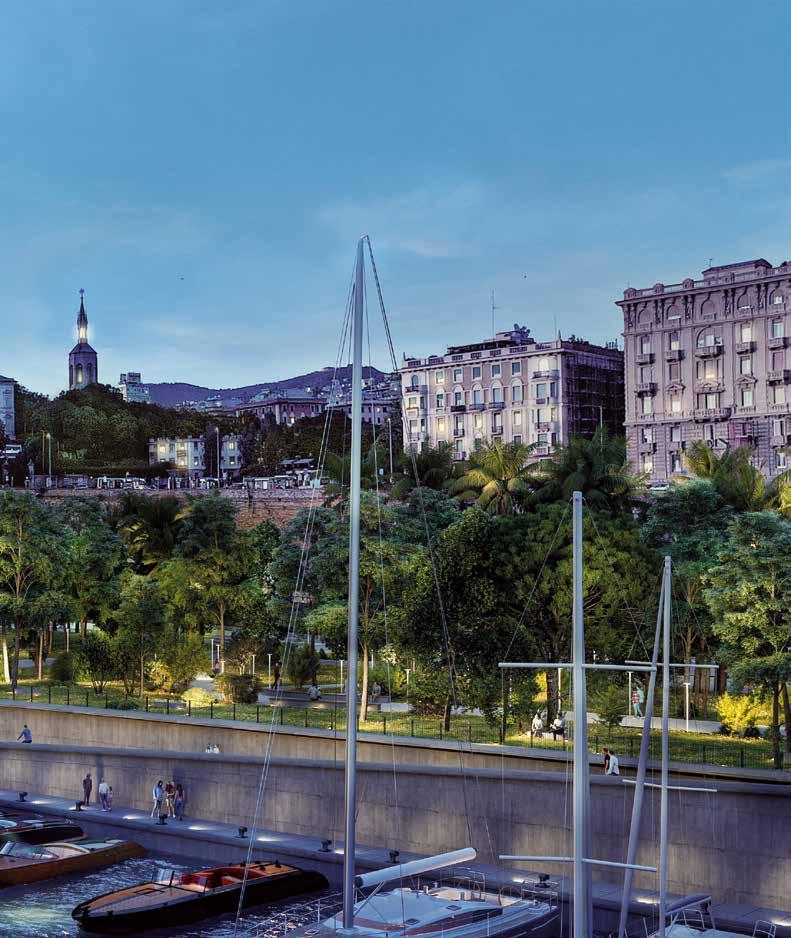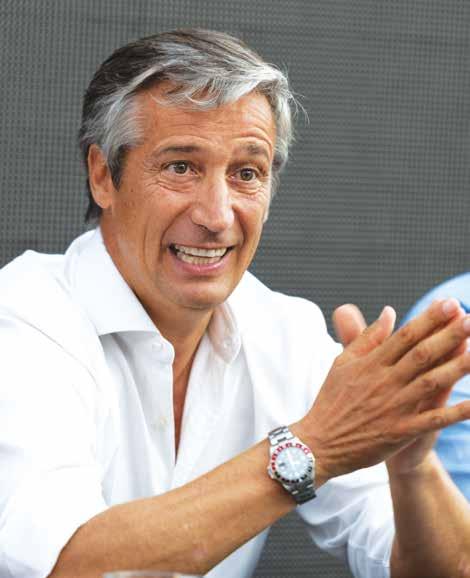
7 minute read
The new voyage of discovery
Uncovering the new Genoa

From its modest beginnings, Genoa, birthplace of Christopher Columbus, has become a key destination for superyachts. Here, Alberto Amico, chairman of Amico & Co, discusses the remarkable qualities that set it apart from the competition.
BY MAX STOTT
In Genoa, the idea of flaunting wealth has been frowned upon for hundreds, if not thousands, of years. That’s why the exteriors of the oldest and grandest residential buildings in the city are relatively bland and underwhelming; all the extravagances have been saved for the interiors.
The Genovese, in general, are also sometimes labelled as being less expressive and welcoming than their fellow countrymen, and this stereotype is somewhat reflected in the city’s architecture. When you enter an old home in Genoa, the first thing you walk into is a vast foyer-style room designed for residents who would only partially accept visitors into their home. This allowed them to bring people indoors only briefly before escorting them outside without revealing the rest of the house.
Despite the city having the values of modesty and reserve entrenched in its DNA, over the past couple of decades the region has become famous for welcoming and accommodating some of the world’s most iconic superyachts.
Indications of Genoa’s historical and notorious connection with the sea are littered all over the city – from the birthplace of explorer and navigator Christopher Colombus near the Piazza De Ferrari to the crest of Sampdoria, one of the two local football teams, which depicts a fisherman smoking a pipe. Some brave historians even go as far as to claim that Britain's favourite dish, fish and chips, actually derives from fritto misto, a typical Genovese dish.
Because of this rich and proud history, Alberto Amico, chairman of Amico & Co, was initially met with some resistance when he first started to attract superyachts to the region. In those days, more than 30 years ago, yachting was a very nascent and misunderstood industry. Today, that sentiment has almost completely shifted.
“It was a big challenge at the start because, as you can imagine, Genoa was not ready for this new industry,” says Amico. “The superyacht industry in Genoa was just a vision that a few people like me and Fabio Pesto, the chairman of Pesto Sea Group, had because we were trying to explore and do some business with this new market.
“In the early Nineties, a big superyacht was considered to be around 40 metres, and at the start we were just picking up clients from places like Rapallo and the French Riviera. Probably 50 to 60 per cent of clients were from Italy. Now, the mayor of the town and the governor of the region are all talking highly about all the businesses that are connected with yachting. But, in reality, this is something that happened after years and years of talking between the stakeholders and the authorities.”
When Amico (& Co) was first opened, Genoa was by no means regarded as a tourist destination. Amico himself notes that until quite recently, it was practically impossible to find a restaurant with a menu that wasn’t written solely in Italian.
In 2006, part of the restored architectural relics of Genoa were put on the UNESCO World Heritage List, and since then the city has continued its transformation into a cultural and artistic destination. This transition has led to what stakeholders in the superyacht industry in Genoa have been longing for, which is for Genoa to open itself up to new and exciting markets.
Businesses such as Amico & Co, apart from just doing a good job, also need to appeal to a variety of different stakeholders; from senior crewmembers to owners, to management companies, to owners’ representatives, there’s no telling who has the most influence on where a yacht goes for a refit. Although Genoa is still something of a ‘hidden gem’, this tends to help businesses like Amico when they are trying to appeal to crewmembers.
Amico explains, “What is really common for us is that crewmembers come to Genoa for the first time, not knowing what to expect, and they end up always wanting to come back. Even just today, I had a captain messaging me saying he can’t believe how amazing the city is and he is sending me pictures all day of the food and the old buildings. You can tell that they weren’t expecting to feel that way about the city.”
This undoubtedly sets Genoa apart from places such as the South of France and Catalonia which are more well known for their ability to cater for highend markets.
Genoa is a city without frills, and the inner workings of Amico (& Co) reflect that. It’s very much a family business and the company is very proud of the fact that all its work is carried out mainly by in-house workers who are a part of the ‘Amico family’. Many of these workers come from a long line of seafarers and have spent decades working in the facilities.
As the years go by, the skills and experience inherited by these workers have become exponentially valuable. Refitting any vessel is extremely difficult, but to do it with the finesse and quality required for a superyacht is a completely different ball game.
Alberto Amico identified shortage of labour as being one of the biggest challenges facing the entire superyacht industry. “When we talk about the workforce we must talk about the actual ability required to perform the job because everybody is [demanding] the same thing, from Northern Europe to Southern Europe. The refit industry isn’t like it used to be, it’s not just seven or eight months on a medium-size yacht and everyone is relaxed. We have megayachts now that need the work done in a very short period of time. This means we need a much higher density of workers.”
Amico adds, “We are lucky in a sense because we have everyone in-house and they are all very specialised with what they do and they are involved with the whole organisation. In terms of cooperation this means we have something different from the standard scheme of subcontractors. We are seeing that other destinations are now struggling to perform the job because companies from the outside need all the separate planning and advances. They don’t have the same ability to move their workforce in a flexible way.”
A familiar face is incredibly valuable in the superyacht industry and the fact that so many returning clients get to work with the same people they know they can trust is a massive benefit for
Alberto Amico, chairman, Amico & Co.


Part of the harbour at Genoa.
the shipyard. Amico notes that, even to this day, a substantial amount of the company’s business derives from positive testimonials and word of mouth.
Amico’s workforce will most likely increase even more now that construction of its new Waterfront Marina has been completed, directly opposite the shipyard and spanning over 43,000sqm of water. With two quays comprising a complex length of 460m and a newly built 70m structural pontoon, it can host 26 vessels up to 110m LOA.
Alberto Amico believes this new development will provide complementary services for crew, managers and owners, and confirm the leadership of Genoa and its territory at an international level.
The fleet is growing massively and new-build shipyards have order books stretching into 2027. This, coupled with the fact that there is an ageing fleet in dire need of being brought back up to modern standards, means that the refit sector will probably have its work cut out in the near future.
The new marina managed by Amico & Co is located inside a municipal area called “Eastern Waterfont”. For this area, usually known to host the Genoa Boat Show, Renzo Piano Building Workshop projected, designed and donated to the city a huge and impressive project that is going to change the face of the eastern area by giving back the city a view over the sea and creating a living space for all its citizens, a new high-class (fancy) urban quarter scheduled to be accomplished within mid-2023.
In just a few years, the entire coastline of Genoa will look completely different, and the expansion of the superyacht
In just a few years, the entire coastline of Genoa will look completely different, and the expansion of the superyacht industry is a major driving component of this transition.
industry is a major component of this transition. Genoa’s long history with the sea will have a new chapter; it will no longer be considered an ‘industrial’ city but rather will appear as a region more akin to the superyacht hubs found across the Western Mediterranean.
The challenge for industry leaders such as Alberto Amico is to make sure Genoa retains the same substance and principles that make it so popular with the many seafarers who have already recognised it for being the remarkable and exceptional destination that it already is. MS










